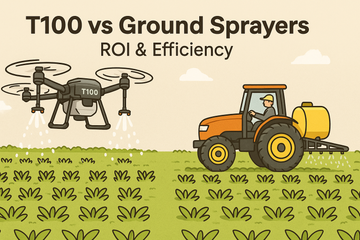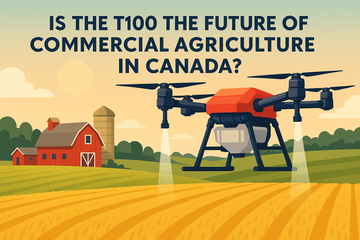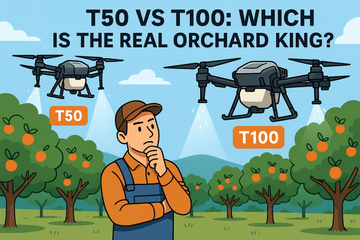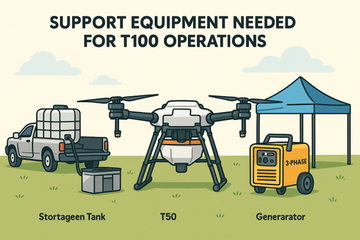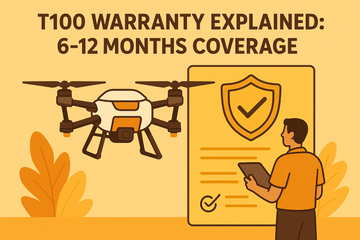Ground Sprayers – The Old Standard
Ground-based sprayers (boom sprayers, tractors, pull-behinds) have been the default for decades. They’re durable and reliable, but they come with drawbacks:
-
Soil compaction from heavy machinery
-
Uneven spraying in orchards and hilly terrain
-
High labor and fuel costs
-
Limited flexibility in wet fields or delicate crops
T100 – Aerial Heavyweight
The DJI Agras T100 is built for large-scale efficiency. With a 100L tank, terrain-following sensors, and autonomous flight planning, it covers hundreds of acres per day without touching the ground.
Key Advantages:
-
Zero soil compaction
-
Faster coverage per acre compared to most ground rigs
-
Precise spraying with dual atomizing nozzles
-
Accessibility: Operates in wet or uneven fields where tractors can’t go
ROI Comparison
-
Ground Sprayers: Lower upfront cost but high recurring costs (fuel, labor, tractor maintenance). ROI typically takes several years.
-
T100: Higher upfront cost (~$35K+) but lower operating costs. Labor savings, reduced chemical waste, and faster coverage mean ROI can be achieved in 1–2 seasons for large farms.
Efficiency in the Field
-
T100 Coverage: 10–12 acres per fill, with 100L capacity; continuous operation possible with multiple batteries and ground crew.
-
Ground Sprayers: Slower in orchards and uneven terrain; efficient on flat row crops but limited by soil conditions.
Best Fit Scenarios
-
T100: Farms over 400 acres, custom spraying contractors, and orchards with dense canopy needs.
-
Ground Sprayers: Smaller farms where compliance or budget limits drone adoption.
T100 vs Ground Sprayers: ROI & Efficiency Comparison
| Feature / Factor | DJI Agras T100 | Ground Sprayers (Tractor/Boom) |
|---|---|---|
| Payload Capacity | 100L per tank | 200–800L (varies by rig) |
| Coverage per Hour | 40–60 acres (with battery rotation & crew) | 20–40 acres (depending on terrain) |
| Terrain Performance | Flies over wet, hilly, or uneven fields with no soil contact | Limited by mud, slopes, and soft soil |
| Spray Accuracy | Dual atomizing nozzles, uniform droplet size, minimal drift | Prone to overlap, drift, or uneven canopy coverage |
| Soil Impact | Zero soil compaction | Heavy machinery compacts soil, reducing yield long-term |
| Labor Required | 1–2 operators + battery/tank support | 1–2 operators, higher fatigue |
| Operating Costs | Battery charging + minimal maintenance | Fuel, oil, tractor repairs, higher recurring costs |
| Chemical Efficiency | Up to 15% less waste per acre due to smart spraying | Higher waste due to drift/uneven coverage |
| Upfront Cost | ~$35K+ | $15K–$25K (depending on size & tractor cost not included) |
| ROI Timeline | 1–2 seasons (large farms 400+ acres) | 3–5 years (depending on fuel & maintenance costs) |
| Best Fit | Large-scale row crops, orchards, commercial contractors | Smaller farms with flat land and existing tractors |
SpeedyDrone’s Take
The DJI Agras T100 doesn’t replace ground sprayers everywhere, but for large farms, it’s a leap forward in efficiency and ROI. With fewer refills, lower chemical waste, and faster coverage, it offers an edge that ground rigs can’t match. The T100 pays off faster for large farms thanks to its efficiency, chemical savings, and ability to operate in terrain where ground sprayers struggle. Ground rigs remain viable for small farms, but for operators managing 400+ acres, the T100 wins on ROI and scalability.
Keywords
-
DJI Agras T100 vs ground sprayers
-
drone vs tractor spraying ROI
-
DJI T100 agricultural efficiency
-
T100 spraying ROI comparison
-
aerial spraying vs ground spraying
-
DJI T100 farm drone cost analysis
-
spraying drone vs tractor 2025
-
DJI Agras T100 large farm ROI
-
drone sprayer vs boom sprayer
-
efficiency of DJI T100 agriculture drone
Hashtags
#SpeedyDrone #DJIAgras #T100 #DroneSprayer #GroundSprayers #FarmTech #AgTech #DroneFarming #SmartFarming #PrecisionAgriculture #LargeFarmSolutions


